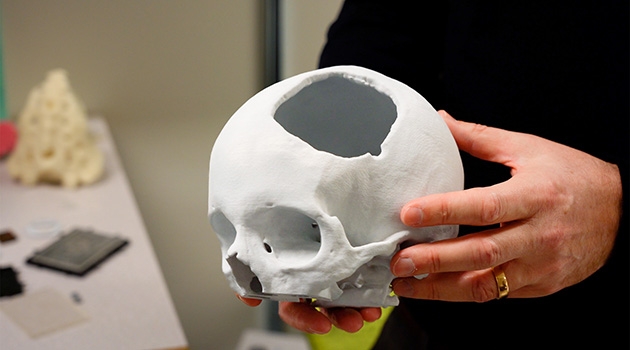3D printing for patient-tailored care
In the future, items such as your medication or a new hip – should you need one – could be printed out using a 3D printer. At U-PRINT, Uppsala University’s 3D-printing facility for medicine and pharmacy, research is conducted into various aspects of this field, including anatomical models that are printed out to help doctors plan operations more effectively.
“3D printing can be used in healthcare to product patient-specific prostheses and implants, and we also use 3D printing to develop apparatus and diagnostic instruments. One very exciting aspect is that we are now beginning to produce tissue with the help of 3D printing,” explains Johan Kreuger, Associate Professor in Molecular Cell Biology and Director of U-PRINT.
The production of tissue is done in a bioprinter, where gels containing proteins and cells are printed out in several layers. This allows a tissue construct to be created, for example skin.
“We can then use tissue constructs for research into how cells and tissues work, as well as drug testing. We will hopefully then be able to carry out many tests in the future without needing to use laboratory animals. In the long term, tissues produced using bioprinting will be able to be used for transplants,” explains Kreuger.
Drug development
Another area of interest for researchers at Uppsala University within 3D printing is the development of drugs. Christel Bergström is Professor of Molecular Galenic Pharmacy at Uppsala University, and her research team works to develop individually tailored drugs.
“3D printers are a great tool for adjusting the dose of drugs, and we are working above all on how to adjust the dose of drugs for seriously ill children,” explains Bergström.
Currently, children are given tablets made for adults, and the tablets therefore need to be split or crushed in order for the children to get the right dose. It is not unusual for as little as two to three percent of the tablet to be the right amount for the child.
“We envisage these technologies being able to move out to patients’ homes in the future. Instead of going to the hospital to get their dose adjusted, they may be able to obtain a 3D printer on prescription – not the drug – with the 3D printer then producing the drug at the patient’s home,” continues Bergström.
Several substances in one tablet
Besides children, many more patient groups could benefit from having their medication personalised in this way and printing out their tablets, capsules or plasters at home.
“An obvious patient group is the elderly population, where we know that metabolism changes over time and a dose adjustment can therefore also be needed. Many elderly people also take lots of different drugs, and a 3D printer enables us to package several active substances into one and the same tablet. Some diseases often need a dose adjustment over time, and we can do that using a 3D printer. For example, 30 tablets could be printed out which scale up the dose over time,” notes Bergström.
According to her, patients could already get access to 3D-printed drugs within a couple of years.
“Our goal is to transfer this technology to Uppsala University Hospital by 2025,” she adds.
Åsa Malmberg

